The Core Collection of the Manuscript Division at the Library of Congress
by Holly H. KruegerIntroduction
The Core Collection of the Manuscript Division at the Library of Congress is a group of 92 objects which has been drawn from the Division's various sub-collections of rare materials so that selected items from the collection can be safely and easily retrieved on short notice to provide in-house presentations to distinguished visitors. The Core Collection is also the central element of a three-tier outreach program conceived by the Manuscript Division to increase public awareness of one of the world's greatest manuscript repositories. The first phase of the project was assembly of the Collection itself by the Manuscript Division and making it safely accessible. This first phase involved the Conservation Office in the examination, documentation, treatment, housing and development of a monitoring plan for the Collection.
Nature of the Collection
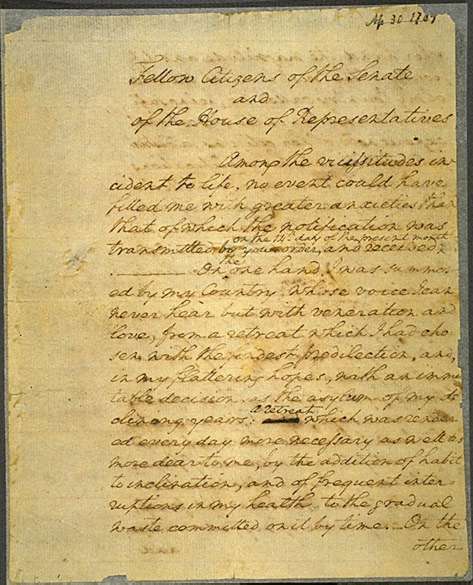
Fig. 1. First Page of George Washington's Inaugural Address, 30 April 1789 (George Washington Papers)
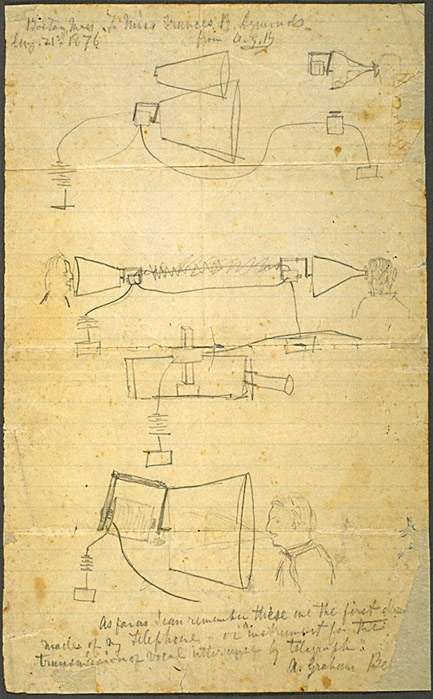
Fig. 2. Alexander Graham Bell's design sketch of the telephone, ca. 1876 (Alexander Graham Bell Family Papers) after treatment.
Objects to be included in the Core Collection were selected by the Division's historians to represent a broad slice of American history and culture. The collection also serves as a dramatic demonstration of the wealth, breadth and depth of the Library of Congress's holdings. While it is difficult to select "highlights of the collection" as the collection is in itself an assembly of "highlights" some of the most significant and/or popular items are George Washington's first inaugural address (Figure 1), Alexander Graham Bell's first drawing of the telephone (Figure 2), Martin Luther King's "I Have a Dream" speech, Thomas Jefferson's recipe for macaroni and his drawing of the machine required to produce it, the First Telegraph Message, Jacqueline Kennedy's letter to Toni Frissell ordering her wedding photographs and Albert Einstein's draft report on theoretical physics.
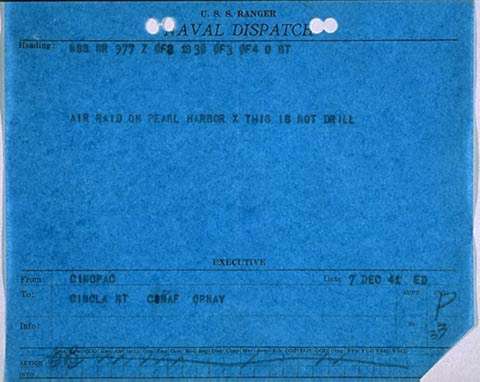
Fig. 3. Naval dispatch from the Commander in Chief Pacific (CINCPAC) announcing the Japanese attach on Pearl Harbor, 7 December 1941 (John Ballentine Papers).
During the months that the Collection was in the Conservation Office, we had the opportunity to participate in a number of presentations to distinguished visitors and were able to witness the enthusiasm the Collection promises to generate. There is something in the Collection for everybody and a brief viewing of as few as three or four selections is enough to spark lively discussion. An important criteria for inclusion in the Collection is a particular object's ability to bring to life an historical event or concept or to humanize an American hero. For example, a Naval Dispatch from the Commander in Chief Pacific (Figure 3) is chilling in its simplicity.
"Air raid on Pearl Harbor X This is not a drill"
The simple, one page directive from president John Adams to his federal department heads demonstrates dramatically some of the differences between then and now as he ordered the relocation of the capital from Philadelphia to the District of Columbia.
"To take the most prudent and economical arrangements...according
to his own best judgement,... as soon as may be convenient"
And, to catalyze a discussion of the proper role and power of the First Lady, one has only to select the letter from Mary Todd Lincoln to her husband in which she urges the replacement of the hesitant General McClellan in one sentence and asks for more household money in the next. It reads:
"And McClellan and his slowness are as vehemently discussed. "Many say they would almost worship you, if you would put a fighting General in the place of McClellan. This would be splendid weather for an engagement."
The next sentence reads,
"I have had two suits of clothes made for Taddie which will come to $26.00 dollars" ......"So I will have to ask for a check of $100.00"
and later,
"I must send you Taddie's tooth"
The second and third phases of the project are designed to facilitate outreach activities to visitors to the Library in Washington as well as in programs throughout the country. The second phase is the assembly of a slide library consisting of images of the Core Collection and the Library's "Top Treasures", as well as photographs of the Conservation Office and individual conservators at work on a variety of materials. The third phase of the project is the production of a video program about the Division and its collections. As with the slide Library, the video will include images from the Core Collection and conservation and preservation information to demonstrate the level of care and attention Special Collections receive at the Library. Both the slide library and the video will be used by the Division's historians as visual aids in presentations to interested community groups and schools, library and archives professional groups and as an aid in fund raising activities. The video will be shown in the Library's orientation theatre and on a monitor outside the Manuscript's Reading Room and will be available for off-site presentations.
Conservation Concerns/Treatment Decision Making Process
As well as illustrating a broad slice of the American historical experience to the general public, the Core Collection also represents for conservators a review of historical approaches to treatments as practiced at the Library. Contained in the Collection are examples of a variety of early mending techniques and materials, housing strategies and treatment techniques such as silking and cellulose acetate lamination. General treatment guidelines were a collaborative effort between the Conservation Office's liaison to the Manuscript Division 1 who conducted the initial survey of the objects, the Head of the Paper Section and the contract conservator. Treatment needs on the Collection varied from re-housing only for 52 of the objects, minor mending on 31 of the objects to complex treatments of 21 objects including delamination and the removal of silking. In general, objects which had not been treated in the past were the ones to receive only minor mending prior to housing. Objects which have been treated by one of the historical methods are considered for reversal after assessing their individual conditions. The decision of whether or not to reverse former treatments such as silking and lamination is driven by several factors. Concern for the instability of the materials used in these former restorations is a major deciding factor. The fragility of the original paper and media is another.2 Secondary, but undeniably important to the ultimate decision, were visual considerations since the objects would be on display in a variety of formats to a very wide audience. The Core Collection is viewed as a show-case for the Manuscript Division and as such, visual considerations carried more weight than may be usual with manuscript material.
An interesting complication to this aspect of the project was the fact that most of the conservation and re-housing work, including the pre-treatment examination, consultation with Manuscript Division personnel, and execution of the developed treatment plan, was to be carried out by an outside contract conservator (myself) and a contract conservation technician. Familiarization with the administrative structure, reconciliation of the various approaches and treatment philosophies of personnel in the Conservation Office, research into early Library restoration techniques and the various experiences with their re-treatment were all important components to the successful completion of the project within the allotted budget. The process was made even more challenging by the fluidity of the final list of objects to be included. Some objects which were originally included and for which resources were allocated were later replaced for one reason or another. Despite many last minute changes, there was the hopeful expectation on the part of all concerned parties to bring the project to completion within the allocated time and monetary budgets.3
Silking
The treatment technique of silking entails adhering silk gauze, sometimes referred to as crepeline, to both sides of a deteriorated document. Before pronouncing judgment on a technique which by today's standards would be considered unacceptably invasive, it is important to gain some historical perspective. At the time of silking's appearance on the restoration front, the main alternative for dealing with deteriorated documents was through reinforcement with a transparent paper. There were various types of transparent papers in use, some of high quality and purity and others which were woefully injurious, impregnated with oils and composed of inferior materials. In addition to the horrendous problems reported with some of these laminating papers, impaired legibility was considered to be a major problem and one which was recognized to worsen with age. Father Franz Ehrle, prefect of the Vatican Library, had published a very influential article entitled "Sur la Conservation et la Restauration des Anciens Manuscripts" in the March-May 1898 edition of Revue des Biblioteques. In this article, he communicated his concerns with transparent tissue repairs and related the "rare ingenuity of the first workman of our workroom (who) called my attention to a tissue of silk, crepeline, as a substitute for transparent paper". 4 Deeply concerned over the fate of deteriorating manuscripts and convinced that he was now in a position to contribute to their salvation, Father Ehrle was instrumental in convening a conference at St. Gallen, Switzerland on September 30 and October 1, 1898.5 Although invitations to the conference were not extended to Americans, correspondence between Dr. Friedenwald, Superintendent of Manuscripts at the Library of Congress, Father Ehrle and other leading figures in the archives community attest to Dr. Friedenwald's deeply felt concern for the collections and his rigor in seeking out the newest and best restoration techniques to be adapted for use at the Library. After obtaining the necessary details on the required materials and technique, silking was introduced sometime in 1899 to the fledgling repair shop established at the Library. At the same time, William Berwick, a bookbinder at the Government Printing Office, was detailed to the Manuscript Division at the Library. Mr. Berwick quickly established himself as the American master in the Vatican technique of silking as well as other restoration techniques and remained at the Library until his death in 1920. The high standards for manuscript restoration as established by William Berwick continued after his death as he was very active in training and left behind a skilled workforce.6
Silking, as detailed in William Berwick's article entitled "The Repairing and Binding of Archives" published in the 1916 Annual Report of the American Historical Association, usually began with immersion into a warm water bath to clean the manuscript of grime and pressing between newspaper, "never the Sunday colored supplement"7, to flatten. In a second separate step, both sides of the document were pasted out with cooked flour paste (he does not detail the recipe in the article) and the silk crepeline was placed on top, and smoothed out. The manuscript was then placed between two sheets of paraffin paper and pressed to flatten between smooth, white, unglazed pulp board. It is difficult to match the variations in the silking materials and techniques of the thousands of silked manuscripts at the Library with their present condition as individual records are rare. Paste recipes varied, as did the silk itself in gauge, color and quality. The silked manuscripts today are certainly in various states of preservation. In all silked documents I have personally examined, the pH is very low, from 3.5-4.0. Some early recipes for the starch paste contain alum and some documents I have tested do test positive for alum, although those in the Core Collection did not. In most cases, the silked documents have darkened considerably and become very brittle. Sometimes the silk itself is in an advanced state of deterioration, more than the document itself, so that the paper and adhesive are supporting the silk rather than the other way around. In other cases, although always yellowed, stiff and unnaturally flat, the document remains relatively intact.
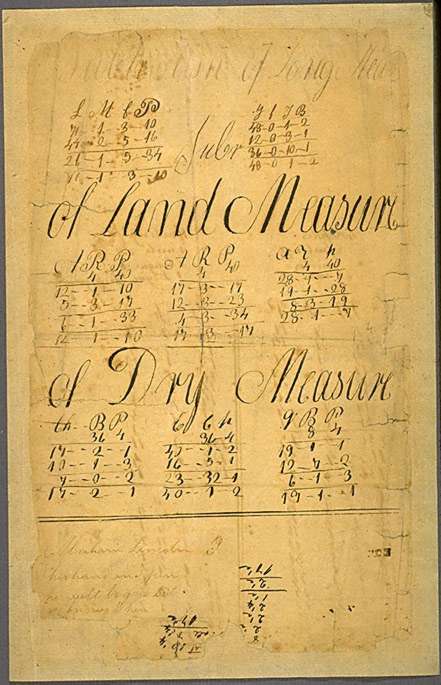
Fig. 4. Page of Abraham Lincoln's student sum book, ca. 1824-26 (Herndon-Weik Collection of Lincolniana in the William Henry Herndon Papers) before treatment
A very rare page from Abraham Lincoln's sum book (Figure 4) which dates from 1824-26 when he was a young student is included in the Collection. It had been silked, presumably at the Library between 1899 and the early 1940's, but as was the case for most documents treated in this period, no individual records exist. The original paper while exhibiting many tears, breaks and losses, maintains enough structural integrity to consider removal of the silking. Upon examination of the object during the project, it was noted that deterioration had continued as evidenced by a surface pH of 3.8. The composite structure was very brittle, exacerbated by the deterioration of the silk itself.
Two distinct inks appear in the manuscript, both exhibiting the characteristics of iron-gall ink. The main text is in Lincoln's hand and the ink is in relatively good condition. The second ink is in a distinct hand and is considerably faded. The water sensitivity of the inks in a silked document can usually be predicted by an assessment of its reaction to the silking process. With the Lincoln sum book, the inks appeared to be water stable and this observation was borne out with spot testing. Of particular concern, however, was the faded inscription
"Abraham Lincoln, his pen and hand, he will be good, but who knows when".
Although the origin of this inscription is in question, it is a great crowd pleaser and any diminishing either in actual mechanical terms or in contrast would be unacceptable. Removal of silk from small discrete areas indicated that the silk could be safely removed with no loss of ink or contrast. Added to this was the experience of numerous conservators at the Library and in neighboring institutions that contrast was a quality which was enhanced by the de-silking and subsequent washing procedures. Of concern was the slight ghost of writing which can be detected on the removed silk in some cases. Based on experience at the Library, it appears that this ghost is a result of discoloration caused by acidic media and/or staining of the silk during the silking procedure rather than removal of ink. In practical terms, this phenomena cannot be predicted prior to treatment and has not been studied sufficiently to alleviate all concern that original material is being removed. The treatment options, risks and possibilities were discussed with the Division's historians who opted for the silk to be removed from the manuscript.
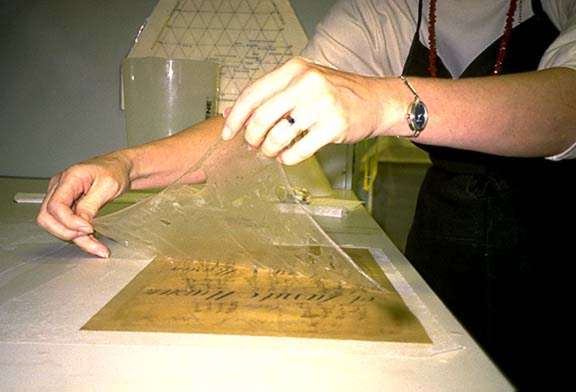
Fig. 5. Removal of the silk from the Lincoln mss.
The following treatment of the Lincoln manuscript was designed to minimize the risk to original material and is based on my own as well as the considerable experience of Library personnel. The manuscript was humidified to increase its receptivity to treatment reagents and to expand the composite structure in a controllable fashion. A sheet of mylar was laid upon a warm water bath and the manuscript laid on top and brushed with a 0.05% solution of alpha amylase 8 and covered with another sheet of mylar. After 10 minutes the silk fabric was easily removed (Figure 5). The manuscript was then immersed in 2 successive baths of 50% recalcified de-ionized water and 50% ethyl alcohol for 15 minutes each. It was then immersed in a 1/4 magnesium bicarbonate 9:1/4 deionized water:1/2 ethyl alcohol bath for 20 minutes to deposit some alkaline reserve. After drying, inserts were fashioned out of Japanese paper laminates toned with Liquitex Acrylics and tears were repaired with similarly toned Library of Congress heat-set tissue. Upon assessment of the effect of treatment it was concluded that the page had gained in strength and flexibility. The page was considerably brightened and its legibility enhanced. Fortunately, no loss of ink could be detected and contrast between the page and both inks was increased as a result of the treatment.
Lamination
Another historical treatment represented in great numbers at the Library is lamination with cellulose acetate film and translucent tissue. Lamination was a widely practiced restoration technique beginning in the late 1930's and early 40's 10. It replaced the technique of silking and began in earnest at the Library with the purchase of a laminating machine from William Barrow. Although many laminated objects were clearly in need of some type of reinforcement treatment, the reasons for lamination of other manuscripts in the Core Collection are less apparent. Several laminated objects in the Core Collection are on good quality, undeteriorated paper and probably treated in response to the pressures for production rather that as the result of a rigorous selection process which takes into account a manuscript's individuality. Here again, it is instructive to understand the historical context in which a particular treatment modality is developed. Lamination was seen as a far superior method to silking and one which received considerable attention from the leading figures in the manuscript restoration field at the time. Its superiority was in speed, reduced specialization of labor and cost, and the fact that it did not require wetting the object. Then, as now, the number of objects rescued from certain deterioration had to be weighed against the needs of individual manuscripts.
When faced with the decision on whether or not to undo former treatments, one must assess their current condition and through largely empirical means, judge the quality of the materials used in the lamination. Between the early forties and 1957 numerous documents were laminated at the Library with tissues and cellulose acetate film of varying degrees of quality. In 1957, the National Bureau of Standards was commissioned by the Library of Congress, the National Archives and others to conduct research into cellulose acetate lamination in an attempt to establish definitive standards. 11 These studies indicated that some of the films that may have been used at the Library may not have been of the highest quality. A second crucial component of the aging characteristics of a laminated document is whether or not the document was de-acidified prior to lamination. Barrow was aware early on that lamination without deposition of an alkaline reserve was detrimental to the paper, due in part to the high temperatures required for melting the cellulose acetate. This concern helped to drive and define his influential studies in the deposition of an alkaline reserve in paper. 12 While it was the recommended practice at the Library to de-acidify using the Barrow Two step method prior to lamination, how often the recommendation was actually practiced is open to some debate. Today, a pH of 6-7 is taken to indicate that the document was de-acidified prior to lamination.

Fig. 6. Telegram, Orville Wright to Bishop Milton Wright announcing the first successful powered flight, 17 December 1903 (Wright Brothers Papers) before treatment
The telegram that the Wright Brothers (Figure 6) sent to their father announcing the success of their first flight is on a thin, machine made wove paper which is in relatively good condition. The letterhead was preprinted in a black ink and the message printed in blue. Both inks and paper colorants tested stable to the acetone required to remove the lamination. The film and tissue were tested for ease of removal and surface pH measurements of the original paper were taken. While the precision of the surface pH measurements is certainly a point of debate, a reading of pH 4.5 was considered a reasonable indicator that the telegram had not been de-acidified prior to lamination. The uncertainty of the materials used, along with the relatively good condition of the original paper and the present ease of removal weighed our decision in favor of delamination at this time. It is also important to acknowledge the anticipated improvement in legibility that removal of the laminated tissue would impart.
To accomplish removal, the telegram was immersed in 6 successive pure acetone baths of approximately 3-5 minutes each. The tissue was easily removed after the first bath, the remaining 5 were necessary for removal of the cellulose acetate. The telegram was subsequently washed in a 75% water: 25% alcohol bath for 30 minutes and then immersed in a 1/4 strength magnesium bicarbonate bath for 20 minutes to deposit an alkaline reserve in the paper. Mending was accomplished with heat-set tissue toned with Liquitex Acrylics.
Housing
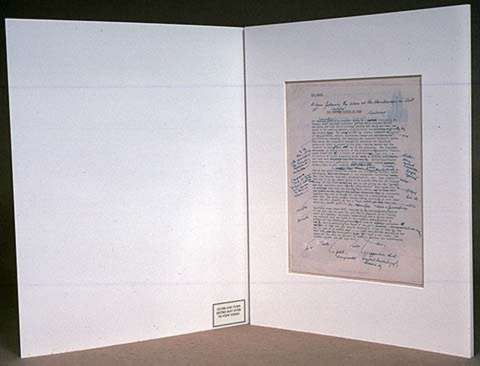
Fig. 7. Recto of the first page of Clare Boothe Luce's corrected draft of her play "The Women", ca. 1936 (Clare Boothe Luce Papers) showing typical housing

Fig. 8. Verso of the first page of Clare Boothe Luce's corrected draft of her play "The Women", ca. 1936 (Clare Boothe Luce Papers) showing typical housing
The housing of the collection required a functional, preventative and aesthetic strategy. All of the objects with the exception of the bound materials were housed in the Library's standard sized mats with 4-ply matboard covers (Figure 7)(Figure 8). The housings included standard and recto/verso mats as well as many more elaborate structures tailored to accommodate the visual needs of the objects while maintaining structural integrity. Because of the uncertainty of the amount of actual handling the collection would receive and the suspicion that it may exceed that which was originally predicted, it was decided to take a preventative posture and polyester encapsulate appropriate objects prior to matting. Criteria used to make this determination included friability and condition of the media and the pH of the paper before and after treatment. Acidic objects which were not to be de-acidified were encapsulated with a thin sheet of buffered tissue. While not transparent, the tissue is translucent enough to allow for reasonable legibility of the reverse. Attached to the mats are object specific informational labels as well as handling precautions. The matted objects are stored in flat storage boxes along with clean white cotton gloves.
As with any collection, particularly one whose use is open-ended and comprised of priceless and fragile objects, monitoring its use once it leaves the Conservation Office is a crucial part of its continuing preservation. While the mechanism of monitoring the Collection's use is evolving and will be re-evaluated as time progresses, the plan in place involves recording the number of times objects are checked out of the collection. Tracking the number of times an individual object is used was rejected by the Division as too cumbersome. We have recommended that the collection be reviewed once a year by the Conservation Staff to assess the success of the housing, to detect deterioration stemming from use and to compare the aging of the re-treated objects with those that remain silked and laminated. Results of the yearly inspection combined with the statistics of usage compiled by the Manuscript Division is expected to result in modifications to the monitoring plan and add to our general body of knowledge. 13
Conclusion
It is important to articulate some of the many questions the project has raised. Decisions on how and why individual objects were treated can always provide fodder for lively discussions. The assembly of the Collection itself raises the inevitable question of the risks to these treasures associated with increased handling and exposure as weighed against the pressures of the need for accessibility. And certainly, closer examination of historical treatments, methodologies and philosophies bears a more rigorous and widespread understanding. Lest anyone be worried that we have destroyed evidence by the few documents we reverse treatment on each year, rest assured that we have the dubious luxury of thousands of identically treated documents in the Library of Congress available for study.
The inclusion of views of the Conservation Office and conservators at work in the Core Collection slide library and video attests to the opinion that Conservation was both an interesting and integral part of the success of the Core Collection project. The potential to expose a wider audience to conservation issues exists through the pictorial inclusion of the Office and conservators at work in the Core Collection slide library and video. Active involvement and continual communication with personnel from the Manuscript Division as well as the upper administration served to enhance the profile of the Conservation Office. We were able to use the opportunities presented for presentations to distinguished visitors during the time that the collection was in the Conservation Office to lobby for preservation concerns and to demonstrate our specialized work.
Another interesting aspect of the project to note is the fact that the actual treatment and housing of the collection was performed largely by contract conservators, supported by outside funding. This attests to the realities of scarce resources and the creativity required to get the job done. These realities are as true in the Library as well as for organizations outside the government. The Core Collection was originally conceived of as a response to the problem of assembling on short notice, ad hoc presentations to distinguished visitors. As the utilitarian, instructional and fund-raising potential of the Collection was realized, the project expanded to include more deliberate outreach activities. The Collection has been successful in providing a resource for the delivery of compelling, interesting and audience specific presentations. In addition to completing the Core Collection Project in a timely and efficient manner, the project attained success on a number of additional levels. These objects, as a direct result of this project can now be safely handled and presented to scholars, distinguished visitors and the general public in a variety of formats. The Conservation Office added to their expertise in the reversal of former treatments. Sensitivity to the motivations behind these former treatments has been heightened. Techniques for the removal of the silking were refined as a result of the Project. The congenial collaboration between many members of our Office and members of the Manuscript Division served to increase the visibility and awareness of Conservation. And finally, the stunning content of these objects served as an effective catalyst for contemplation in many areas.
Acknowledgements
The Core Collection Project was supported through a generous donation by the Madison Council at the Library of Congress. Thanks go to Doris Hamburg, Head of the Paper Section, for her support and leadership and to Sylvia Albro, Senior Paper Conservator, for making the collaboration an enriching and pleasant experience. Thank-you to Lage Carlson, Head of Phased Conservation, and Mary Studt, Contract Conservation Technician, for their imaginative and well executed housings. And special thanks go to Marvin Kranz, Historian from the Manuscript Division in charge of the project whose unparalleled enthusiasm for the manuscripts succeeds in making American history come to life.
Notes
1. Each of the 9 Divisions at the Library has a representative from each of the three sections (Book, Paper and Phased) of the Conservation Office. These liaisons are responsible, among other things, for communicating directly with the Division personnel, establishing preservation priorities within that Division, and coordinating the work which results.
2. Some objects were considered too fragile to withstand immersion into even a partially aqueous system such as 25% water:75%ETOH and/or the physical separation of the silk fabric from the surface of an original. For example, a sales contract between Jefferson and Madison for an indentured servant had been severely damaged by mold prior to its silking. The original paper had so little structural integrity that it was decided not to risk removal of the silking at this time.
3. Little time for historical and analytical research on individual objects was built into the project. As a result, it was decided to postpone treatment consideration of Washington's first Inaugural Address until more in depth research could be conducted. Because of its stature as an individual object, it was decided to argue for research time to be added to the Manuscript Division's annual budget. Research is currently being conducted by a Library senior paper conservator.
4. Nicholson, E.W.B. " Report by Bodley's Librarian to the Curators of the Bodleian Library on the Conference held at St. Gallen, Sept. 30 and Oct. 1, 1898, upon the preservation and repair of old mss., " December 22, 1898, p. 12, quoting Father Franz Ehrle, "Sur la Conservation et la Restauration des anciens Manuscripts," Revue des Biblioteques, March-May, 1898.
5. Marwick, Claire S. "An Historical Study of Paper Document Restoration Methods", Master's Thesis, The American University D.C., 1964 p.84.
6. Ibid., p 87-98.
7. Berwick, William "The Repair and Binding of Archives", Annual Report of the American Historical Association for the Year 1916 , Vol. 1, 1916.
8. The alpha amylase used was Calbiochem #171568 with an Activity level of:1,595 AU/mg.
9. The magnesium bicarbonate being diluted is the Library full strength solution which is between 7 and 8 1/2 grams of magnesium bicarbonate per liter.
10. Marwick, ibid., p. 120-139.
11. Stiber, Linda "The Delamination of the Washington & Lee Ledger: Part 1 An Overview Of Cellulose Acetate Lamination", Early Advances in Conservation, British Museum Occasional Paper N. 65, 1988.
12. Barrow, W. J., Manuscripts and Documents, Their Deterioration and Restoration, University of Virginia Press, Charlottesville, Va.
13. An interesting challenge which accompanies contract conservation work is in the transfer of the subjective knowledge gained through the experience of treatment of the objects. Although documentation of this aspect of our work is inherently challenging it becomes more critical when the conservator is available for only a short, definite time period.
Holly H. KruegerSenior Paper Conservator
Library of Congress
Publication History
Received: Fall 1995
Paper delivered at the Book and Paper specialty group session, AIC 23th Annual Meeting, June 4-1, 1995, St. Paul, Minnesota.
Papers for the specialty group session are selected by committee, based on abstracts and there has been no further peer review. Papers are received by the compiler in the Fall following the meeting and the author is welcome to make revisions, minor or major.